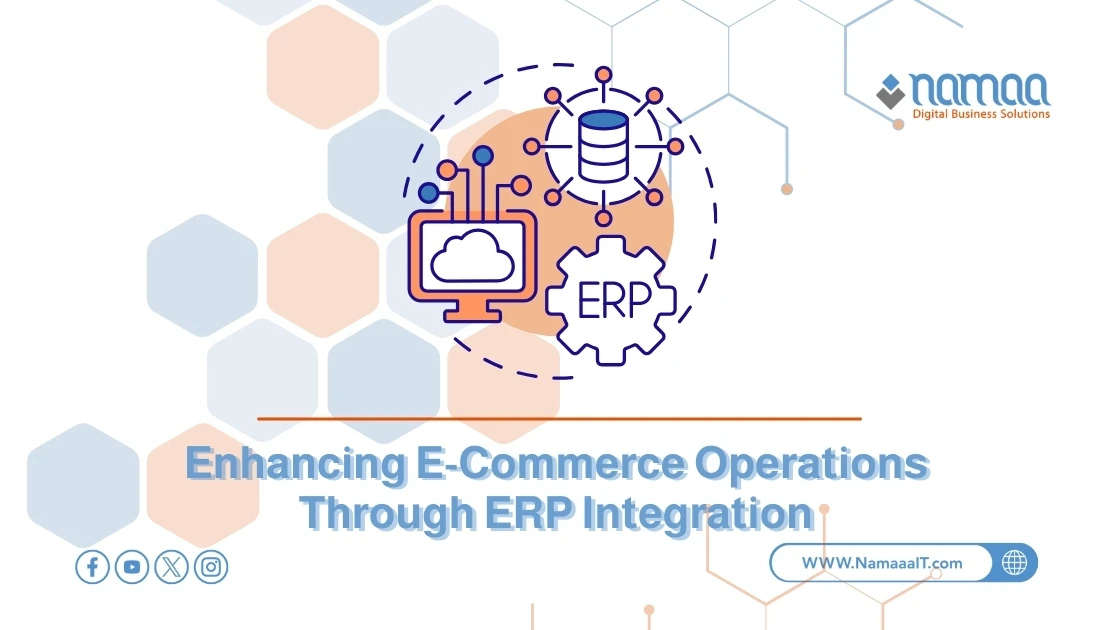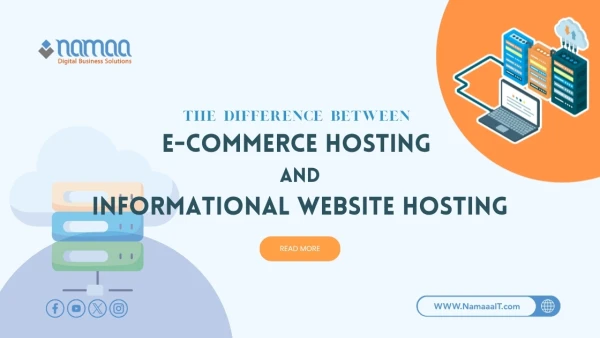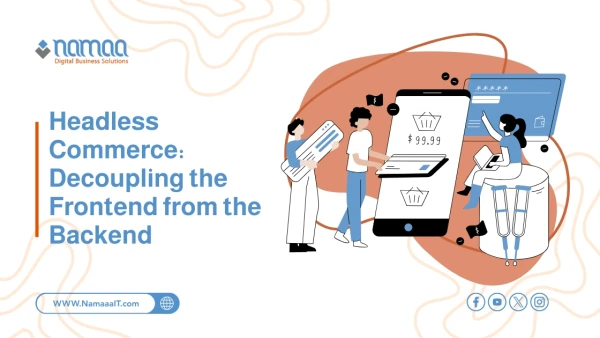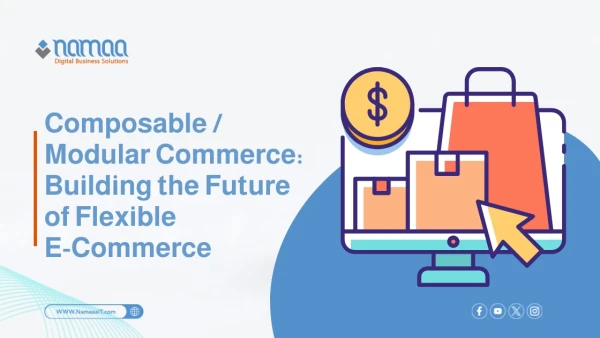In the fast-paced world of e-commerce, relying solely on an online store is no longer enough to ensure success and sustainability. Businesses face growing challenges in inventory management, order tracking, and delivering a seamless customer experience. This is where Enterprise Resource Planning (ERP) integration plays a crucial role in enhancing e-commerce operations.
This integration goes beyond improving operational efficiency — it provides real-time accurate data, automates processes, and reduces human errors. By integrating e-commerce platforms with ERP systems, companies can gain a comprehensive view of their operations, enabling strategic decisions based on reliable data. Additionally, this integration improves the customer experience by offering accurate product availability, delivery times, and order tracking.
In this article, we’ll explore how ERP integration can be a game-changer for enhancing e-commerce operations and achieving the flexibility and efficiency required in today’s digital market.
What is an ERP System, and Why Does E-Commerce Need It?
Enterprise Resource Planning (ERP) is a software platform designed to unify and manage a company's core operations in one centralized system. It includes functionalities like accounting, HR, inventory management, supply chain, procurement, and sales. Traditionally used by large enterprises to reduce complexity and integrate departments internally, ERP has now become essential — not optional — for e-commerce businesses.
E-commerce stores operate in a rapidly changing environment, with data flowing from multiple sources: customers, inventory, orders, shipping, and payments. Without a centralized system to manage this data, operations can quickly become chaotic, increasing the risk of costly errors in orders or financial reports. An ERP acts as the backbone of the operational structure, providing a unified data source that can be updated and shared in real-time across departments.
It also reduces dependence on manual data entry, minimizing errors and improving information accuracy. Simultaneously, it provides a full view of inventory, sales performance, and operating costs — making it easier for management to make well-informed decisions.
Without an ERP system, online stores are forced to rely on separate tools for each function, increasing operational costs and making growth more difficult. In short, ERP is not just a performance upgrade — it's fundamental to building a scalable and resilient e-commerce business.
How ERP Integration Enhances E-Commerce Operations
Integrating ERP with e-commerce platforms transforms fragmented operations into a unified, intelligent system. When ERP is directly connected to the online store, data flows automatically between the two systems — eliminating the need for manual updates of orders, inventory, or shipping information. This kind of integration boosts efficiency, shortens order fulfillment times, and delivers a more consistent and professional customer experience.
One of the most noticeable impacts is inventory synchronization. When a product is sold on the site, the ERP system updates inventory levels across all channels automatically, preventing overselling and maintaining customer satisfaction. ERP reports also provide real-time insights into sales volumes, best-selling products, and regions with the highest demand — supporting smarter marketing and distribution decisions.
Furthermore, integration enables full order lifecycle tracking — from purchase to delivery. Customers receive automated notifications and feel confident throughout the process. Internally, operational costs decrease as repetitive tasks are reduced, and the response time to problems like delayed deliveries or out-of-stock items improves.
ERP integration also opens the door to automating post-sale services such as invoicing and return management. The more automation is implemented, the more the team can focus on strategic growth instead of time-consuming manual tasks. This transformation directly improves e-commerce store performance and enhances competitiveness in a demanding market.
How ERP Supports Expansion into New Markets
One of the biggest challenges when entering new markets is efficiently managing operations without compromising service quality. ERP plays a vital role here, offering a flexible infrastructure that supports expansion without added complexity. With a robust ERP system in place, launching a new channel — whether it’s an international marketplace or a multilingual, multi-currency store — becomes a matter of configuration and management, not guesswork.
ERP helps localize operations by supporting multiple currencies, tax regulations, and accounting standards. This enables businesses to sell in various countries smoothly without requiring separate systems. ERP also tracks performance by market, helping analyze growth, optimize pricing, and adjust strategies per target audience.
Another critical aspect is supply chain optimization. ERP can connect directly with global suppliers, enabling smart inventory planning and avoiding delays or product shortages. It can also manage cross-border shipping processes and integrate with customs and required documentation — streamlining expansion and reducing risk.
Finally, centralized ERP reporting allows leadership to measure the success of expansion efforts without manually compiling data from each market. This means faster decisions, clearer insights, and better control over growth, all of which are essential in a competitive, high-speed digital environment.
ERP Integration with Payment and Delivery Systems
When ERP is integrated directly with payment and delivery systems, it creates a significant leap in operational efficiency. Payment operations — usually disconnected from accounting and inventory — become part of a unified financial cycle. Once a customer completes a payment on the website, the transaction is automatically recorded in the ERP’s accounting module, updating customer accounts, taxes, and inventory instantly.
This reduces accounting errors and ensures immediate alignment between revenue and actual payments. It also supports accurate invoice generation that complies with local and international laws — which is especially critical for multi-market selling. ERP can generate comprehensive financial reports covering daily performance, collections, currency differences, and payment methods, helping businesses make informed, timely decisions.
On the delivery side, ERP integration means that each paid order is automatically forwarded to the appropriate shipping provider with accurate details such as the customer’s address, order type, and estimated delivery time. This accelerates order processing, minimizes delays, and enhances customer satisfaction.
Moreover, ERP can track shipping status, send real-time notifications to customers, and link delivery updates to performance reports — turning delivery into an integrated part of the shopping experience, not just a follow-up stage. This integration leads to faster, cheaper, and more reliable operations that inspire customer confidence.
Learn More: AI-Powered E-Commerce Platforms
How to Choose the Right ERP System for Your Store
Choosing the right ERP system for your e-commerce store is a strategic decision that will shape your operational efficiency and business growth:
Start by assessing your business size and process complexity. Smaller stores might only need simple inventory and invoicing tools, while mid-sized and large businesses require full-featured ERP solutions that support supply chains, international shipping, accounting, and customer service.
Ensure seamless integration with your e-commerce platform, whether you use Shopify, PolarisMAX, Magento, or others. This is essential for automatic inventory updates, order tracking, and unified data management. Also, verify compatibility with your preferred payment gateways and shipping providers, as this directly affects customer experience and fulfillment speed.
Choose a scalable system. Your ERP should grow with your business — accommodating more products, new markets, or team expansion without needing a complete system replacement. Don't forget to consider user-friendliness and training needs, especially if your team is small or non-technical.
Review licensing costs, technical support, and post-sale services. Some systems may seem affordable upfront but lack proper support when needed — which can lead to higher long-term costs. Read customer reviews and ask for a demo if possible. The right ERP system is not just a tool, but an investment in stability and growth readiness.
Success Stories of ERP Integration
ERP systems have become the backbone of operational efficiency and sustainable growth. Real-world examples of companies that successfully implemented ERP integration demonstrate how transformative it can be:
Ronin Gallery, a New York-based art gallery, integrated NetSuite ERP for inventory and sales management — leading to major operational efficiency improvements and a better customer experience.
→ ERP used: NetSuite
Asteelflash, an electronics manufacturing service provider, adopted QAD ERP to unify operations across 17 global locations, enabling fast growth and scalable operations.
→ ERP used: QAD ERP
Glider Guard, a mold and tool manufacturing company, used Genius ERP to modernize its processes and expand its production capacity — helping meet growing demand and improve product quality.
→ ERP used: Genius ERP
These examples show that ERP integration is not just a technical upgrade — it’s a strategic move for achieving operational excellence and global expansion.
Summary:
✅ Ronin Gallery improved operational efficiency by 35% after integrating NetSuite ERP, reducing order processing time and cutting operational costs.
✅ Asteelflash unified its operations across 17 global sites with QAD ERP, achieving 12% annual growth through supply chain optimization.
✅ Glider Guard increased production capacity by 40% with Genius ERP, meeting rising demand without delivery delays.
✅ Companies implementing ERP integration saw a 70% reduction in billing and financial processing errors within the first 6 months.
✅ Over 80% of companies integrating ERP with e-commerce reported improved customer experience and an average 25% increase in customer satisfaction.









